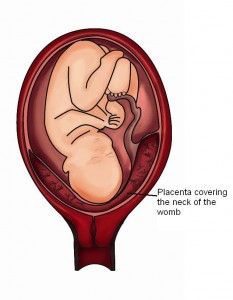
Diagram 1: Placenta previa Type 4 covering the os of the cervix
What is placenta previa?
Placenta previa means your placenta is situated low in your womb (uterus) next to your neck of your womb (cervix) or covering the cervix. Placenta is a pan-cake shaped organ which is usually located at the top of your womb and supplies your baby with the oxygen and nutrient she / he needs through the umbilical cord.
How is it diagnosed?
It could be detected as early as 20 weeks as low lying placenta. About 10% of women with low lying placenta will have persistent low lying placenta later in the pregnancy. Placenta previa is usually diagnosed based on scan at after 28 weeks when the lower segment of your uterus is formed.
What are the different types of placenta previa?
There are 4 types of placenta previa:
- Type I: Placenta lies between 2 to 5cm from the opening of the cervix.
- Type II: Placenta edge touches the opening of the cervix. The placenta could lie anterior or posteriorly in the womb.
- Type III: Placenta partially covers the opening of the cervix. The placenta could be situated anterior or posteriorly in the womb.
- Type IV: Placenta totally covers the opening of the cervix.
Type I and II anterior placenta previa are known as minor placenta previa. Whereas Type II post, III and IV are known as major placenta previa. These patients with major placenta previa will require caesarean section.
Who is at risk for placenta previa?
- History of placenta previa in previous pregnancies
- Women carrying twins or more as the placenta tends to be larger
- History of previous C-sections
- History of surgery on the uterus i.e previous DD&C or fibroid removal
- Cigarette smoker or cocaine user.
In addition, the older you are and the more babies you have had previously, you may be at increased risk of placenta previa.
What happens if I’m diagnosed with placenta previa?
Depending on what type of placenta previa you have. You will be asked to avoid sexual intercourse especially you have been bleeding. In those with placenta previa major you will be asked to be admitted for prolonged hospital stay usually after 30 weeks of pregnancy as there is a risk of bleeding. In hospital you will be monitored for any signs of vaginal bleeding. If you have any anemia, you will be treated. An elective C-section will be schedule for at about 38 weeks of gestation.
What complications could occur with placenta previa?
You might have profuse vaginal bleeding leading to preterm delivery and prematurity of your baby. Excessive bleeding during C-section even though electively could lead to massive blood transfusion and even risk of hysterectomy (removal of your womb) in order to save your life. Your baby is also at risk of growth restriction. Another less common complication is
placenta accreta in which the placenta is abnormally stuck to the womb. This will be discussed in further details in another separate section.
RECOMMENDED BOOKS:
[easyazon-image align=”none” asin=”1561487171″ locale=”us” height=”160″ src=”http://ecx.images-amazon.com/images/I/41AyhH3XGkL._SL160_.jpg” width=”107″] [easyazon-image align=”none” asin=”B003EMNSIW” locale=”us” height=”160″ src=”http://ecx.images-amazon.com/images/I/51klgh0jOrL._SL160_.jpg” width=”106″] [easyazon-image align=”none” asin=”B006M49TNM” locale=”us” height=”160″ src=”http://ecx.images-amazon.com/images/I/519T-AWB9pL._SL160_.jpg” width=”120″] [easyazon-image align=”none” asin=”0984480404″ locale=”us” height=”160″ src=”http://ecx.images-amazon.com/images/I/51X%2Bly6M1kL._SL160_.jpg” width=”107″] [easyazon-image align=”none” asin=”0789210797″ locale=”us” height=”160″ src=”http://ecx.images-amazon.com/images/I/51Hz9fmP50L._SL160_.jpg” width=”112″]
Filed under Bleeding in Pregnancy | No Comments








